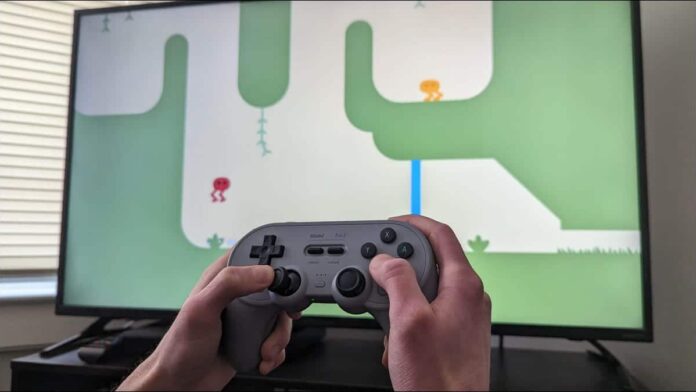[ad_1]
The phrase PC gaming often conjures up images of sitting at a desk bathed in RGB light, clicking your mouse, but there’s no reason you can’t take your PC gaming experience and transport it to a comfy sofa and a TV setup.
Use home streaming
People seem quite happy to stream games from hundreds of miles away, so why not from the other side of your house? You can use Steam Home Streaming (as an example) to stream your gameplay from your computer to a client device.
Client devices can be a variety of things. There are Steam client apps for tablets, phones, smart TVs, and of course other laptops. So you could, for example, install Steam on your MacBook and connect it to your TV as a streaming receiver for your gaming PC.
Don’t forget that you can add non-Steam games to the Steam client to launch those games, which means they’ll work with home streaming as well.
Get a gaming laptop
If streaming isn’t your thing, you can always invest in a gaming laptop and then plug it into your TV or just play it right on the couch (plugged in, of course) while someone else uses the big screen to watch Netflix.
There is not much more to say about it; you can play a gaming laptop wherever you can find a power outlet. You might even want to invest in a lap desk or table under the sofa if you’re not going the TV route.
Build a Mini Gaming PC
The best thing about desktop PC games is that you can build a computer in any design you want. As long as the components are given enough power and cooling, they will live happily in whatever house you give them.
You can get one of the many Mini ITX or other SFF (small form factor) cases on the market and then fill it with components designed to fit in those cases. Or you can go all out and build a custom chassis to fit your needs if you know your way around a shop.
No matter how you do it, it’s possible to build a PC that fits perfectly alongside game consoles, Blu-ray players, and other typical living room gadgets.
Use a mouse and keyboard on your lap
Everyone knows that you can use a controller with a PC to play games, but many games work better with a mouse and keyboard. Wireless mice and keyboards work well enough these days for gaming, especially the gaming-specific models, but they’re not nearly as easy to use on a couch.
That is unless you have a specialized solution for using these peripherals on your lap. A great example is the ROCCAT SOVA, but you can also use one of the many lap trays designed for laptops to house your keyboard and mouse if you’re on a strict budget.

Using video extenders and peripherals
It might sound like a silly idea at first, but you can also make your own cables. In fact long so you can position them from where your PC is to where your sofa is. The most efficient way to do this is via Ethernet and a combination of USB to Ethernet and HDMI to Ethernet converters.
Sure, it’s a pain to set everything up neatly and route the cable from point A to point B, but once you’re done, you can easily switch between using your PC from the couch and using it at your desk. If you’re particularly averse to running cables, you might consider using Powerline Ethernet or HDMI over Powerline. This would use your home’s electrical wiring to carry the data, but the Powerline network is subject to several factors that can limit your bandwidth and increase latency, especially if your wiring is old.
RELATED: How to make an even longer USB cable
Control your mouse pointer with a gamepad
One major fly in the ointment of gaming on your PC from the couch is that Windows and other desktop operating systems weren’t designed to be controlled with a gamepad. If you don’t want to keep a mouse and keyboard close at hand, there are a few ways you can make your controller act like a mouse for navigating the operating system. If you use Steam Big Picture Mode, it will automatically allow you to move the mouse with the right stick when necessary and click the right trigger.
You can also use apps, like Gopher 360 or Keysticks, to control your entire Windows computer using one gamepad.
RELATED: How to make your Windows gaming PC automatically start in large picture mode (like a steam engine)
[ad_2]
